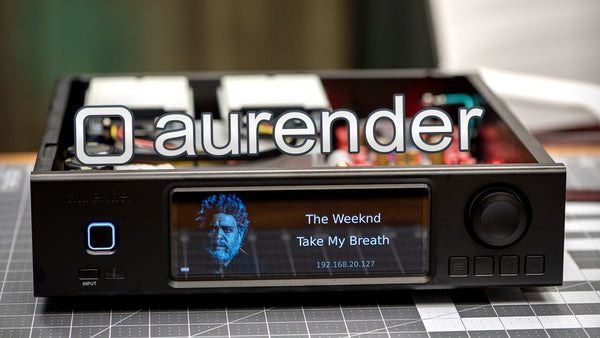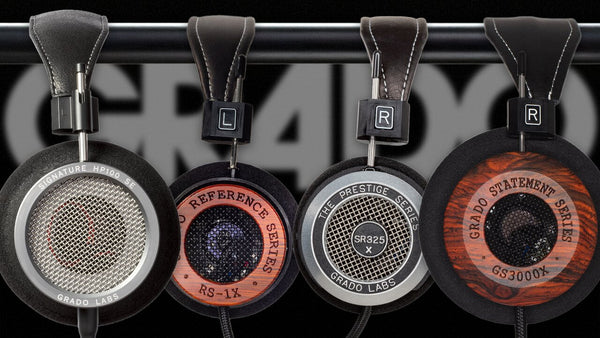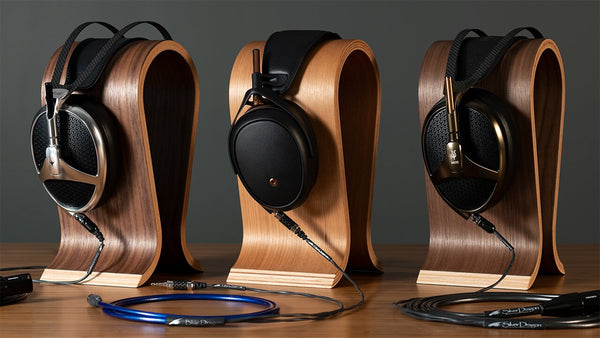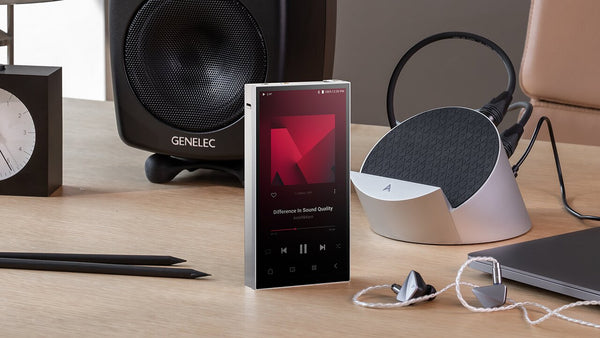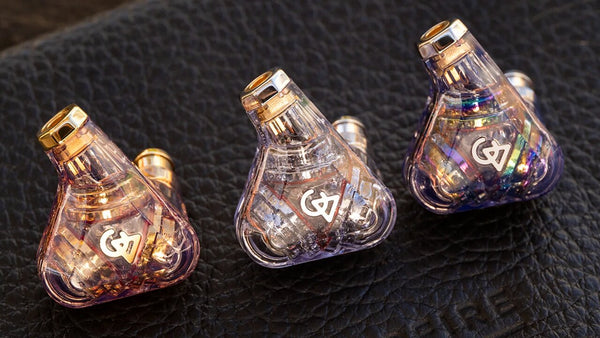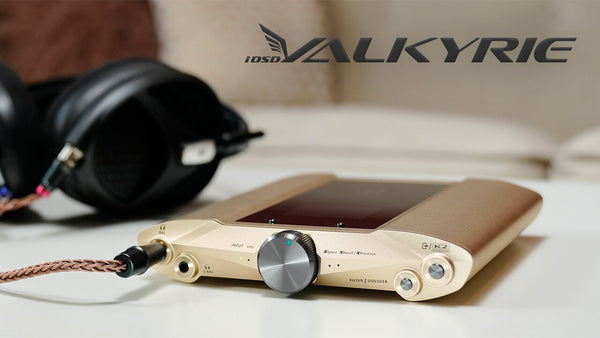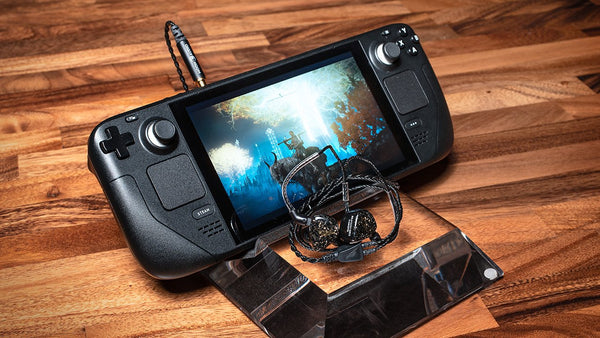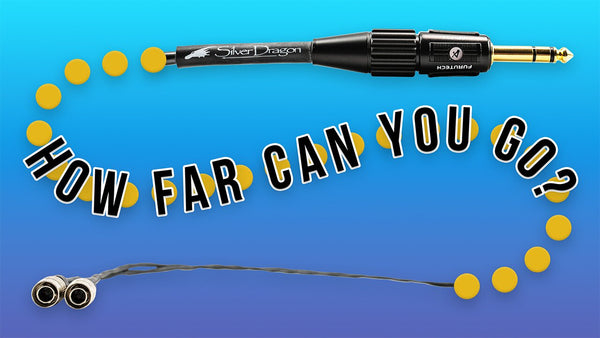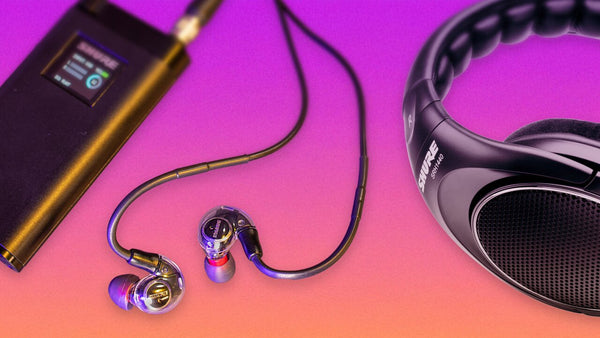Empire Ears IEMs: Complete Guide

Everything You Need to Know About Empire Ears High-End In-Ear Monitors
A renowned American audio company specializing in high-end in-ear monitors (IEMs), Empire Ears has been designing and manufacturing universal and custom IEMs for a decade. As a family-owned company with over 30 years of experience in acoustic engineering and manufacturing, Empire Ears established itself as a major player in the hifi audiophile market. Empire Ears offers a range of IEM models catering to different listener preferences and budgets. The company's product lines often feature evocative names like "Legend," "Odyssey," and "Wraith," reflecting their commitment to creating memorable audio experiences.
Extraordinary sound quality on and offstage may be the destination, but the passionate team at Empire Ears refuses to compromise during any stage of the journey. Every IEM is tested against the highest standards so audiophiles, audio professionals, and music enthusiasts alike can enjoy their music just the way the artist intended. Empire Ears Magazine is your all-inclusive information guide with everything you need to know about the Atlanta-based company's premium custom and universal in-ear monitors.
Empire Ears X Series of IEMs

Designed for audiophiles and music lovers alike, the X Series taps into the best of Empire Ears' proprietary technology and custom-made components to give you all of the energy and emotion of a live performance. The X Series collection of both hybrid (two driver types) and tribrid (three driver types) models is built to overwhelm the senses with a raw and instinctive sound. These IEMs are known for their exceptional sound quality and are often paired with high-end DAPs (Digital Audio Players), DACs, and amplifiers to achieve the best possible audio performance.
Empire Ears Triton IEM
Sound Signature: Warm side of Neutral
Introducing Empire Ears' latest IEM innovation, the Triton IEM. The Triton IEM represents Empire Ears legacy of precision and innovation, embodying the company's relentless pursuit of extraordinary sound and celebration of a decade in business. This marvel seamlessly blends classic Empire Ears craftsmanship with an all-new tribrid, dual conduction architecture. The Triton features Empire Ears' signature W9+ subwoofer, precision-engineered EMP75 balanced armature, and next-generation dual high-mass bone conductors. These three technologies combined provide a rich, immersive, and distinctly bold Empire Ears sound that has defined the industry over the past decade and continues to set new standards.
For an elevated listening experience, we recommend pairing the Empire Ears Triton IEM with our Dragon IEM Cables. The Silver Dragon IEM Cable is our top-of-the-line flagship audio cable, using UP-OCC silver conductors to deliver a clear, articulate listening experience. It's designed to maximize the amount of detail, clarity, air, and instrument separation you get from your IEMs. It's a smooth and clean-sounding cable that will balance warm or dark-sounding IEMs. The Black Dragon IEM Cable boosts detail while adding bottom-end weight to your IEMs. This silver-plated copper cable will increase clarity and resolution while providing a bump in warmth and fullness. It's a wonderful match for IEMs with a V-shaped sound. The Bronze Dragon IEM Cable is our warm and musical-sounding IEM Cable, delivering a fuller, balanced sound with the perfect balance of warmth and detail. The Bronze Dragon uses UP-OCC copper conductors to warm, expand, and strengthen the bottom end for an improved presentation of any thin or bright-sounding IEMs.
Empire Ears Raven Universal IEM
Sound Signature: Airy, Emotive, Big Bold Sound
One of Empire Ear's latest universal IEMs, the RAVEN IEM is full of energy. With a big, bold sound that's full of musicality, you just can't help but tap your feet and move to the music when listening to the Raven. It brings excitement to the forefront with a hard-hitting articulate bass and a top end that's not shy by any means. At the forefront of the RAVEN is the W10 Bone Conductor. This groundbreaking driver delivers unparalleled imaging, intricate nuance retrieval, and rich timbre by transmitting sound through bone conduction. The result is an immersive sonic experience that engages the listener on a truly profound level. Five balanced armature drivers work in tandem to render and captivating and pure midrange that truly brings music to life.
The RAVEN's black chassis is sleek and inconspicuous in the ears. Not to mention how lightweight and comfortable they are. Empire Ears has continued to make huge innovative strides in their technology and the RAVEN shows us that they're not slowing down any time soon.
We recommend pairing the Empire Ears RAVEN IEMs with the Silver Dragon IEM Cable. The Silver Dragon is going to tighten up the bass of the RAVEN, making it even more powerful and controlled. UP-OCC Silver has a way of adding gain to the frequency range due to the super low resistance. Things become even more airy-sounding with added emotion at the top end.
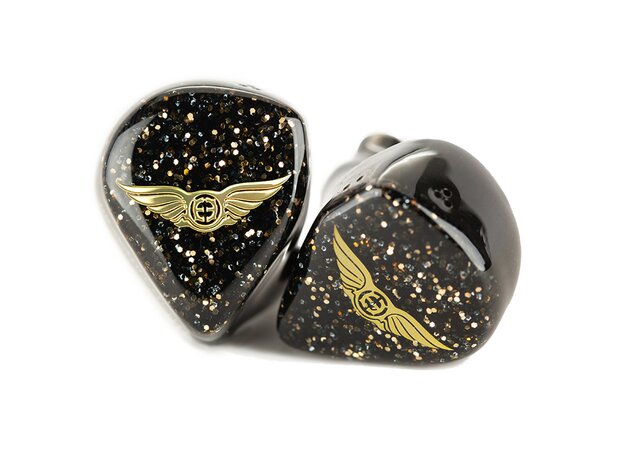
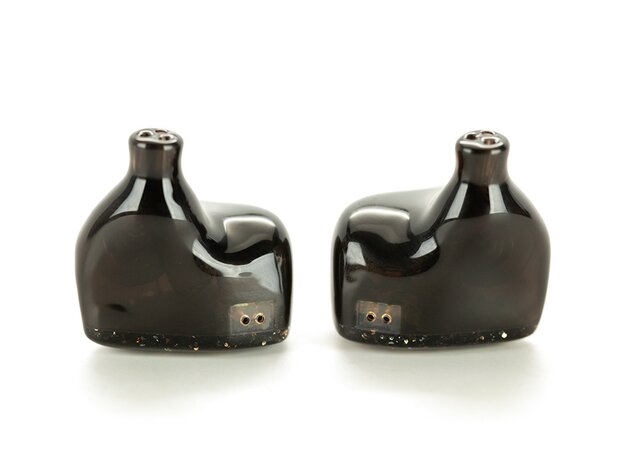
Empire Ears Bravado MKII IEM
Sound Signature: Warm side of Neutral
The Bravado MKII is Empire's entry-level IEM–an all-purpose model that performs well in all genres. The Bravado MKII retains everything good about the original Bravado while getting a big boost in resolution and separation, thanks to the addition of two premium electrostatic drivers. With a slightly warm sound and much larger soundstage than the original, the overall effect is good, old-fashioned, unpretentious fun. The Bravado MKII features Empire Ears Weapon IX+ subwoofer, dual electrostatic drivers and EIVEC system to bring a nuanced and layered presentation that heightens the listening experience to new levels of musicality and analytical enjoyment.
Known for its engaging and fun sound signature, the Bravado MKII is tuned to emphasize bass response and overall musicality. It's designed to provide an energetic listening experience with an enhanced low-end presence, making it particularly appealing to bass enthusiasts and listeners who enjoy genres like EDM, hip-hop, and rock. As a custom IEM, the Bravado MKII is designed to fit your ears and your ears only, meaning you get the utmost comfort when listening for extended periods of time. The bespoke nature of custom IEMs also ensures optimal sound isolation and frequency response tailored to your ear canal shape.
We recommend pairing the Empire Ears Bravado MKII IEM with the Black Dragon IEM Cable. The Black Dragon marries the sonic strengths of the Silver Dragon and Bronze Dragon IEM Cable, delivering a warm and smooth sound with a musical presentation. Copper strands enhance the body, shape, and immediacy of the music, while silver enhances detail and clarity. The detail and expansiveness of the Black Dragon make it a flexible fit where a broad range of musical genres are played.

Empire Ears Hero IEM
Sound Signature: Warm, Mid-Forward
The Empire Ears Hero IEM has the energy, emotion, and performance of the Legend X, without the Legend X price tag. The Hero delivers shimmery highs, prominent vocals, and a low end that reaches deep enough to give real life to instruments like the double bass and cello. Featuring a hybrid driver configuration of balanced armature drivers and the Weapon IX+ subwoofer, the Hero delivers the fun, front-row feel of a live performance that will have you grooving in your seat.
We recommend pairing the Empire Ears Hero IEM with the Black Dragon IEM Cable. The Black Dragon marries the sonic strengths of the Silver Dragon and Bronze Dragon IEM Cable, delivering a warm and smooth sound with a musical presentation. Copper strands enhance the body, shape, and immediacy of the music, while silver enhances detail and clarity. The detail and expansiveness of the Black Dragon make it a flexible fit where a broad range of musical genres are played.
Empire Ears Legend EVO Universal IEM
Sound Signature: Bassy, Energetic
Like the Legend X, the Empire Ears Legend EVO IEM has a huge, powerful sound, with a masterful and copious low end that will please even the most die-hard basshead. The thing that makes the Legend EVO stand out from other IEMs, including its predecessor Legend X, is the visceral quality of the sound, and the way you experience it both inside and outside of your body. But the Legend EVO has a big soundstage that allows all instruments to claim their space rather than being drowned out by the bass. With a dual-conduction architecture and eight-driver tribrid system, the Legend EVO emits unprecedented levels of innovation and performance to create a new benchmark in the IEM industry. Its high impedance may require a powerful amplifier or DAC/amp combo to drive it to its full potential, showcasing the ODIN IEMs for an enjoyable listening experience.
We recommend pairing the Empire Ears Legend EVO IEMs with the Silver Dragon IEM Cable. The Silver Dragon is our top-of-the-line flagship audio cable with silver strands clarifying instrument separation, increasing the soundstage, and finding previously lost high and mid-frequency sounds. The detail and clarity of the Silver Dragon IEM Cable will tame the bassy and energetic sound of the Legend EVO for a pleasant listening experience. For optimal sound quality, consider using high-quality eartips from brands like Final Audio, which can further enhance the fit and acoustic performance.
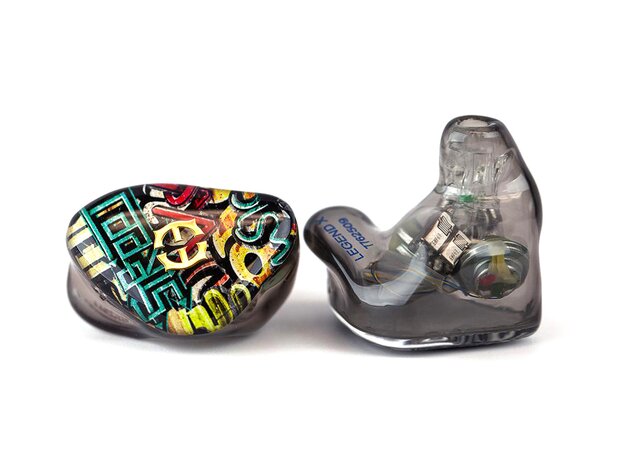


Empire Ears Legend X Custom IEM
Sound Signature: Fun, Balanced, Bassy
If you're looking for one of the widest and most three-dimensional soundstages available in an IEM, look no further than the Empire Ears Legend X. From its arsenal of 7 proprietary drivers (including twin sequential W9 subwoofers) to its industry-leading, state-of-the-art 10-way synX crossover network, the Legend X is the culmination of everything extraordinary at Empire. The Legend X delivers top-tier transparency; smooth, energetic treble; and an impactful low end that combine for a fun and engaging experience. As a custom IEM, the Legend X is designed to fit your ears and your ears only, meaning you get the utmost comfort when listening for extended periods of time.
We recommend pairing the Empire Ears Legend X IEM with the Black Dragon IEM Cable. The Black Dragon marries the sonic strengths of the Silver Dragon and Bronze Dragon IEM Cable, delivering a warm and smooth sound with a musical presentation. Copper strands enhance the body, shape, and immediacy of the music, while silver enhances detail and clarity. The detail and expansiveness of the Black Dragon make it a flexible fit where a broad range of musical genres are played.
Empire Ears ODIN Universal IEM
Sound Signature: Natural, Balanced
For mortals who seek a listening experience that is nothing short of godly, the Empire Ears ODIN IEM brings the best of everything Empire has done to the table: the three best IEM driver technologies available, with the most advanced crossover system in the industry, the finest quality materials, and masterful tuning. The ODIN is grand and enthusiastic but controlled, with a totally natural signature and clarity that rivals the ESR MKII without being overly analytical. In the words of Empire co-founder Jack Vang, the ODIN is the very personification of Empire's DNA at its most extreme -- in design, performance, and breadth of capabilities. Its impedance and sensitivity make it compatible with a wide range of sources, from smartphones to dedicated DAPs and amplifiers.
We recommend pairing the Empire Ears ODIN IEM with the Silver Dragon IEM Cable. The Silver Dragon is our top-of-the-line flagship audio cable with silver strands clarifying instrument separation, increasing the soundstage, and finding previously lost high and mid-frequency sounds. The detail and clarity of the Silver Dragon IEM Cable will accentuate the performance of the ODIN IEMs for an enjoyable listening experience.
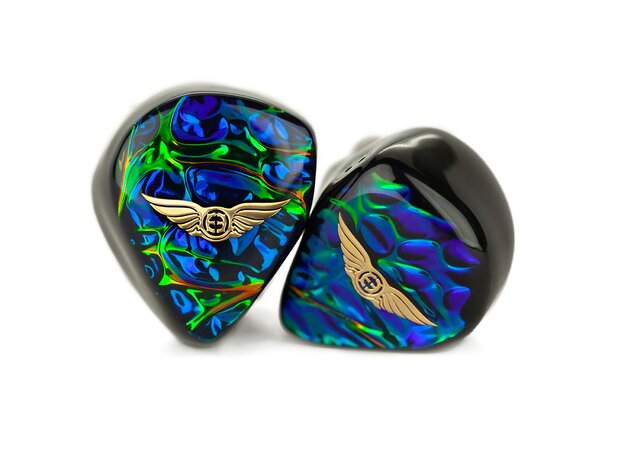
Empire Ears Valkyrie MKII IEM
Sound Signature: Fun, Highly Energetic
See if you can keep up with the energy of the Valkyrie MKII, Empire's first Tribrid IEM. Better acoustics in a larger shell (over the original model) make for tighter low-end impact, while a Weapon IX+ subwoofer offers richer resonance without any loss of sub-bass. A balanced armature driver for the mids and an electrostatic driver for the highs round out a signature that includes crisp and detailed highs and clear, lush mids. The Valkyrie MKII is popular with audiophiles who like and energetic and captivating signature.
We recommend pairing the Empire Ears Valkyrie MKII IEM with the Black Dragon IEM Cable. The Black Dragon marries the sonic strengths of the Silver Dragon and Bronze Dragon IEM Cable, delivering a warm and smooth sound with a musical presentation. Copper strands enhance the body, shape, and immediacy of the music, while silver enhances detail and clarity. The detail and expansiveness of the Black Dragon make it a flexible fit where a broad range of musical genres are played.

Empire Ears Vantage IEM
Sound Signature: Warm, slightly mid-forward
The Empire Ears Vantage IEM is a remarkably smooth in-ear monitor that delivers supreme clarity across the entire frequency spectrum. The Vantage features a 4-way synX crossover network to maximize performance from the twin sequential W9 subwoofers and mid/high balanced armature driver. Known for its balanced and slightly warm sound signature, the Vantage IEM offers a natural and engaging listening experience.
We recommend pairing the Empire Ears Vantage IEM with the Black Dragon IEM Cable. The Black Dragon marries the sonic strengths of the Silver Dragon and Bronze Dragon IEM Cable, delivering a warm and smooth sound with a musical presentation. Copper strands enhance the body, shape, and immediacy of the music, while silver enhances detail and clarity. The detail and expansiveness of the Black Dragon make it a flexible fit where a broad range of musical genres are played.
Empire Ears EP Series of IEMs

The Empire Professional (EP) Series represents the highest standards in audio reproduction. Designed for mixing on stage or in the studio, the EP Series delivers music as it was meant to be heard. Crystal-clear sound, incredible isolation, and anti-fatiguing properties are the hallmarks of this lineup. If you're looking for a top-tier IEM that's suitable for wearing all day, look no further than the EP Series.



Empire Ears ESR MKII Universal IEM
Sound Signature: Reference, Linear
The Empire Studio Reference (ESR)MKII is the IEM for professionals and audiophiles alike for whom truth and reference are paramount. Every bit of information within a file is here for the listener to observe and dissect. The ESR MKII features a 5-driver hybrid configuration, consisting of triple balanced armatures and dual electrostatics, alongside a completely reengineered 4-way synX crossover network driven by EIVEC and ARC technology. This technology effortlessly reproduces the sonic transparency and critical details needed for monitoring, mixing, and mastering. Dual electrostatic drivers give detail and separation in the high end.
The ESR MK-II is Empire's flattest IEM, delivering a pure, unadulterated sound, ultra-fast transient response, and wide dispersion. It's a popular choice with sound techs on films, recording and mixing engineers, and front-of-house engineers. With a sleek and ergonomic design, the ESR MKII IEMs offer a comfortable fit for extended listening sessions. Available in a custom variation, listeners can get the perfect fit from custom molds, pick a unique faceplate design that suits them, and enjoy hours of fatigue-free listening.
We recommend pairing the Empire Ears ESR MKII IEMs (universal and custom) with the Silver Dragon IEM Cable. The Silver Dragon is our top-of-the-line flagship audio cable with silver strands clarifying instrument separation, increasing the soundstage, and finding previously lost high and mid-frequency sounds. The detail and clarity of the Silver Dragon IEM Cable make it a perfect match for individuals using the ESR MKII for studio monitoring and technical listening.
Empire Ears Wraith Universal IEM
Sound Signature: Dark side of Neutral
The Empire Ears Wraith Universal IEM is the world's first quad electrostatic IEM featuring Empire's EIVEC (Empire Intelligent Variable Electrostatic Control) technology. Seven balanced armature drivers, two transformers, and four electrostatic drivers combine to provide world-leading treble extension, rich and precise mids, and an earthy, tight low end. In the Wraith, EIVEC uses two transformers to bring the quadruple Electrostatic drivers into order, dividing the duties of the EST drivers and blending them seamlessly with the seven balanced armature drivers which fill out the rest of the robust sound profile. The result is an enormous soundstage in which no detail is overlooked. It's like sitting alone in an auditorium in front of your own personal orchestra. You'll hear music like never before with great clarity, texture, and detail.
We recommend pairing the Empire Ears Wraith IEMs (universal and custom) with the Silver Dragon IEM Cable. The Silver Dragon is our top-of-the-line flagship audio cable with silver strands clarifying instrument separation, increasing the soundstage, and finding previously lost high and mid-frequency sounds. The detail and clarity of the Silver Dragon IEM Cable make it a perfect match for individuals using the Wraith for studio monitoring and technical listening.


Empire Ears Phantom Universal IEM
Sound Signature: Balanced
A legacy Empire Ears IEM, the Phantom is a reference IEM whose mission it is to let the music speak for itself. It's a versatile IEM that will please both music professionals and audiophiles. A smooth, laid-back sound with just a touch of warmth, Phantom boasts excellent treble extension as well as bass that knows when to shine and when to take a step back. The Phantom features a sophisticated driver configuration consisting of five balanced armature drivers, carefully tuned to deliver a balanced and neutral sound signature.
One of the Phantom's key technologies is the synX crossover network, which aims to eliminate phase incoherence and ensure optimal performance from each driver. Additionally, EIVEC is incorporated (despite not using electrostatic drivers) to manage the balanced armature drivers effectively. Known for its natural and uncolored sound presentation, the Phantom is often praised for its ability to reproduce music with high fidelity to the original recording.
We recommend pairing the Empire Ears Phantom IEM with the Silver Dragon IEM Cable. The Silver Dragon is our top-of-the-line flagship audio cable with silver strands clarifying instrument separation, increasing the soundstage, and finding previously lost high and mid-frequency sounds. The detail and clarity of the Silver Dragon IEM Cable make it a perfect match for individuals using the Phantom for studio monitoring and technical listening.

Empire Ears EVR MKII Universal IEM
Sound Signature: Balanced, Slightly Forward Mid-Range
The Empire Vocal Reference (EVR) MKII is the next generation of the original EVR IEM, designed for the highest vocal reproduction quality. The EVR MKII delivers highly accurate and detailed sound with a slightly forward midrange that allows vocals to shine. It retains the superior clarity, separation, and detail of its predecessor while delivering even more dynamic range. The EVR MKII uses a hybrid driver setup, combining balanced armature drivers with electrostatic drivers. Increased soundstage and separation from two electrostatic drivers highlight rich female vocals and make choral arrangements sound divine.
Like other Empire Ears products, the EVR MKII likely incorporates proprietary technologies such as the synX crossover network, which is designed to optimize the performance of the multiple drivers and ensure coherent sound reproduction.
We recommend pairing the Empire Ears EVR MKII IEM with the Black Dragon IEM Cable. The Black Dragon marries the sonic strengths of the Silver Dragon and Bronze Dragon IEM Cable, delivering a warm and smooth sound with a musical presentation. Copper strands enhance the body, shape, and immediacy of the music, while silver enhances detail and clarity. The detail and expansiveness of the Black Dragon make it a flexible fit where a broad range of musical genres are played.
Empire Ears: The Pursuit of Extraordinary
Who is Empire Ears?
Empire Ears is driven by a singular obsession: to create the world's finest universal and custom IEMs (in-ear monitors). Under the unwavering dedication and boundless vision of co-founders Dean and Jack Vang, the Atlanta, Georgia-area company is consistently one-upping itself in its effort to achieve that goal.
This father-son venture is defined by a spirit of "design the extraordinary and achieve the impossible." "Can't" simply doesn't exist in the Empire lexicon. The company has enjoyed an ever-mounting string of successes during its first five years, culminating in (but by no means ending with!) the 2020 release of its new flagship Odin model.
Joining the X Series lineup of audiophile-quality IEMs, the 11-driver ODIN brings the very best of everything Empire Ears has accomplished to the table. Also joining the X Series in 2020 was Hero, a four-driver hybrid model.

Empire Ears Fast Facts
Founded: 2015
Headquarters: Norcross, GA
Co-Founder/CTO: Dean Vang
Co-Founder/VP: Jack Vang
CEO: Catherine Young
An Empire is Born
Begun in 2015, Empire Ears is an offshoot of Jack Vang's previous EarWerkz venture. As the son of a musician who spent years designing and manufacturing hearing aids and OEM in-ears, Jack developed a case of audiophilia at a young age. In 2014, wanting to develop a "next-generation" IEM, Jack launched a project on Kickstarter. He tapped his father Dean's company for design and manufacturing, and a line of EarWerkz IEMs was born.
The fledgling company saw immediate success–so much so that Jack and his team were on the verge of being overwhelmed. As the father-son design/sales partnership had proved fruitful, they decided to go "all in" together, forming Empire Ears in 2015. It was a move that Jack said led to a quadrupling of manufacturing and developing power. With Jack as vice president and Dean as chief technology officer and "mad scientist," Empire has quickly grown into a globally recognized leader in the IEM market coveted by recording artists, recording engineers, audiophiles, and more.
10 Years of IEM Innovation
Empire's first IEM series was Olympus. Its flagship model, Zeus, was joined by siblings Spartan, Athena, Cerberus, Hermes, Apollo, and Supra II, all featuring custom-built balanced armatures. These IEMs enjoyed a huge following, but the Vangs were just getting started. During the next couple of years, R&D was the order of the day at Empire Ears. Next to make its debut was Empire's proprietary A.R.C. anti-resonance technology, which, when applied to drivers and other components, corrects distortion and ear fatigue.
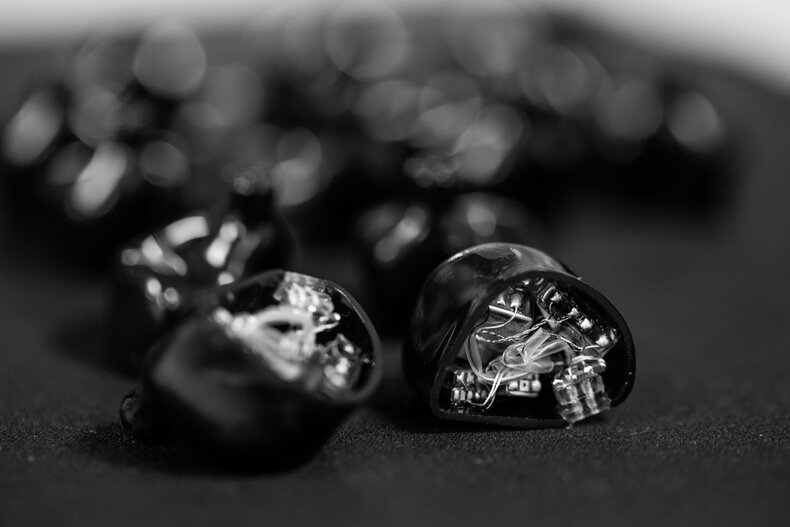
In 2020, Empire unveiled Odin and Hero, which joined the X Series IEM lineup. Odin, a tribid 11-driver, 7-way crossover model, is said to represent the very best of everything that Empire has brought to the table during the past five years. Hero, a hybrid four-driver, 6-way crossover model, draws on elements of the Zeus and best-selling Legend X.
Over the last decade, Empire Ears has pushed leaps and bounds, unveiling groundbreaking technology that's flipped the IEM industry on its head. Empire Ears is constantly chasing the extraordinary and that's evident through your continual releases of universal and custom in-ear monitors.
A Culture of Excellence
State-of-the-art design and impeccable craftsmanship are hallmarks of Empire Ears IEMs. Each individual component is inspected by hand, and every IEM is meticulously assembled from the finest materials. From silver-plated copper wires and striking jewel-tone shells to faceplates crafted from exotic imported wood, Empire Ears strives to make its IEMs look as good as they are technologically advanced.
Nearly every Empire IEM is available as a custom model, with numerous eye-catching design options. Shells are available in a range of translucent and opaque colors, with glitter as an optional add-on. Faceplates come in standard and premium options including burl wood, carbon fiber, and abalone. Signature designs are available, too. As for artwork, you can opt for logos, Swarovski crystals, or even provide your own design.
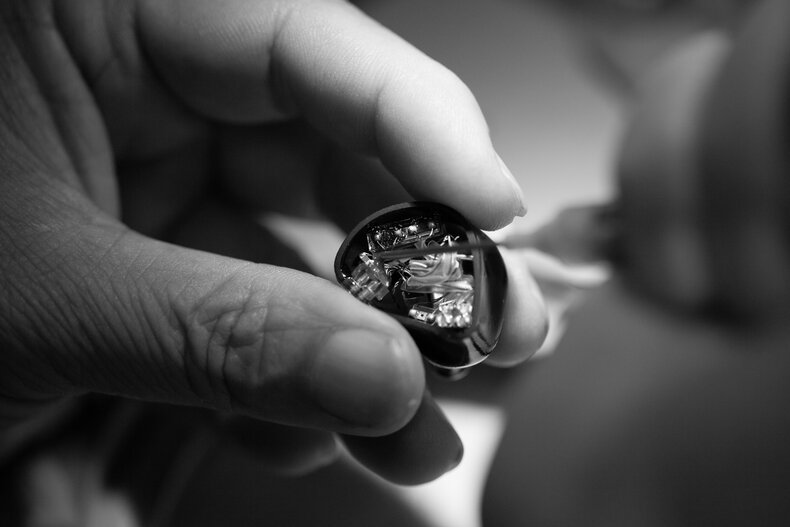
Each handcrafted CIEM (custom IEM) requires a full-shell ear impression completed by an audiologist, and Empire Ears can work with the customer to find the right fit.
Customer service has always ranked paramount among Jack Vang's priorities, and buyers can expect a highly personalized approach. It's not an exaggeration to say that everyone at Empire Ears shares a deep passion for the company, and they want customers to feel it, too.
A glance at Empire Ears' website reveals a "family" of passionate customers, including performing artists, recording engineers, worship leaders, and more. Likewise, one needn't spend long on Empire Ears' social media channels to get a sense of a strong, loyal, super-satisfied "family" following. For high-performance sound you can see and feel, check out Empire Ears IEMs. And welcome to the family!
Empire Ears IEM Technology
Empire Ears will never settle for good enough. It's evident in their relentless drive to dream up and perfect the technologies that fill each IEM shell. These proprietary technologies are designed to take your listening experience to new heights, with superior control, unmatched clarity, low distortion, satisfying bass, and much more.
A.R.C (Anti-Resonance Compound) Technology: Empire Ears' Answer to Distortion and Ear Fatigue
As an IEM listener, there's nothing worse than distortion and ear fatigue. A.R.C is Empire Ears' answer to in-shell resonance that can lead to distortion and ear fatigue. Balanced armature drivers in particular are prone to unwanted distortions, peaks, and vibrations. Empire does apply a dampening agent to its balanced armature drivers, but noise interference can still affect the sound due to other components interacting with these drivers. A.R.C. technology all but eliminates vibrations and resonance from within the IEMs themselves.
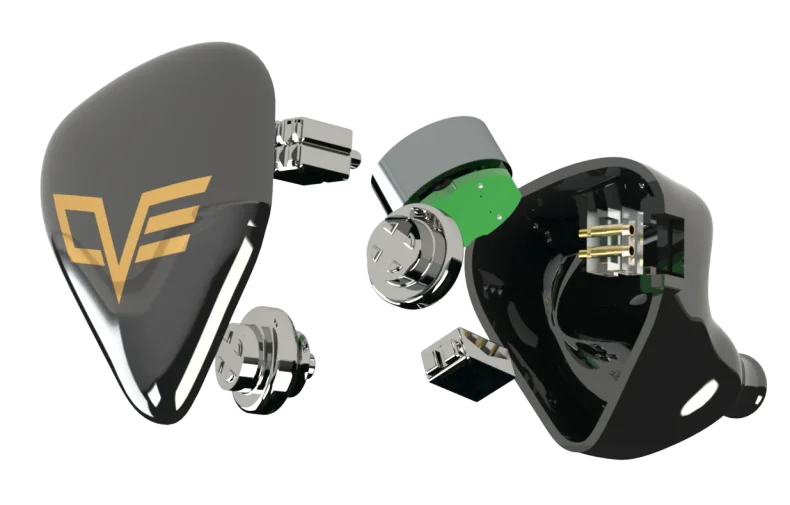
A.R.C. is an advanced polymer coating that has its roots in the natural resins that form in large, deciduous trees. The resins harden into a durable rosin that can absorb vibrations and reverberations. This coating is designed to have a precise density-to-rigidity ratio to maximize the absorption of unwanted vibrations. If it's too rigid, the coating will transmit too much vibration. If it's not rigid enough, it will end up mucking up the sound. The optimum amount of rigidity in A.R.C. coating adds a layer of shock protection to every component within each IEM. After it is applied, it dries into a coating that adds to the relative mass of each IEM component. Giving more solidity to these parts helps them to absorb unwanted resonance instead of reflecting it out of phase. The result is increased clarity, deeper bass, and higher overall efficiency.
A.R.C. also helps cut down on the persistent, out-of-phase buzz present in many other companies' balanced armature-driven technology. That buzz, which your ear perceives as noise or annoyance, can lead to ear fatigue or headaches, because your brain is trying to decipher it while also hearing the music. That buzz can be worse in IEMs with a high degree of isolation (custom fit models). A.R.C. results in much cleaner sound with no phase interference.
EIVEC (Empire Intelligent Variable Electrostatic Control): Creating Harmony Between Electrostatic and Other Drivers

You take the good, you tame the bad. In the case of electrostatic drivers, the "good" is their expansive 4Hz-100kHz frequency range. They produce the higher tones (beyond what we can even hear!) that are necessary for maximum detail and resolution in your music. The problem is that electrostatic drivers tend to drown out balanced armature and dynamic drivers. When they are too dominant, the IEM can sound too bright, leading to ear fatigue. When Empire Ears began adding electrostatic drivers to some of its IEMs (beginning with the Wraith), it wanted to do so in a way that would maximize the detail-giving benefits without compromising the overall sound of an IEM.
EIVEC technology was designed by Empire Ears specifically to manage electrostatic drivers in their hybrid IEM designs. With EIVEC technology, one or more transformers unite up to four separate electrostatics, eliminating phase incoherence and distortion. The transformer essentially isolates the electrostatics from the other drivers, thus "taming" them while allowing them to perform to their best potential. In the Wraith, for example, two transformers are used to bring the four electrostatic drivers under control, dividing the jobs of each of those drivers and allowing them to work in harmony with seven balanced armature drivers.
synX Crossover Technology: Maximizing the Performance of Each Driver Type
Empire Ears IEMs utilize up to three driver types: balanced armature, dynamic, and electrostatic. The synX Crossover Technology in each Empire Ears IEM is designed to maximize the performance of each of those driver types, creating cohesion and unity. The proprietary synX design -- the most advanced IEM crossover technology in the industry -- designates more individual audio bands per driver than any other crossover technology on the market.
Essentially, a crossover pulls frequency bands from an audio signal and assigns them to the driver that will most effectively reproduce them: dynamics for the lows, balanced armatures for the mids, and electrostatics for the highs. No two drivers will receive the same signal.

Each Empire Ears model has its own handcrafted, hand-tuned synX Crossover Network -- up to a 10-way crossover in the seven-driver hybrid Legend X. A variety of top-secret resistors, electrolytic capacitors, splitters, filters, and other technologies are soldered in-line to tune Empire Ears IEMs. This network of hardware splits the signal into multiple frequency bands, delineating those bands to specific drivers.
By creating an ultra-wide, multi-channel "highway," Empire Ears can manipulate parts of the frequency range to create the target response and eliminate phase incoherence between drivers. No phase incoherence means no ear fatigue. Through the power of synX Crossover Technology, Empire Ears IEMs deliver honest and pristine sound with a high degree of stereo separation, low distortion, and the smoothest phase response on the market.
Weapon IX/IX+ Drivers: Subwoofer-like Bass in a Dynamic Driver
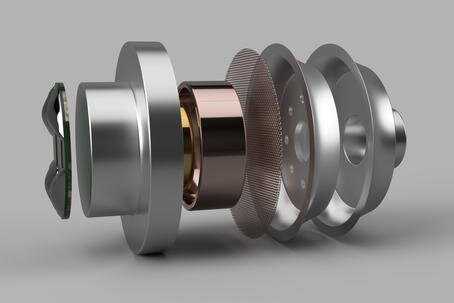
Much of music is experienced through the subsonic frequencies. The subwoofer is the reason you genuinely feel the impacts and low tones while listening to films or music as the sound waves pass around and through you. This sensation is one of the things that add a full and rich quality to the time you spend listening. Empire Ears has developed a driver technology that can handle subharmonic frequencies better than any other IEM driver on the market. The Weapon IX, or W9, featured in all Empire Ears X Series IEMs, is a rare-earth magnet dynamic driver that functions like a true subwoofer in your ear. At a whopping 9mm, this proprietary dynamic driver brings the full force of your music to your ears, hitting you with the essence of a true subwoofer. Every kick drum hit, snare triplet, or reverberation of a slapped bass note will be felt as much as it is heard.
Traditional dynamic drivers can suffer in low-octave frequencies and very much rely on internal shell enclosures for volume, limiting form factor and vastly reducing efficiency with limited extension. The key to the W9's performance is that the woofer is enclosed in a tuned bass-reflex system with a front-firing port and rear-firing vent. This helps to reduce distortion and boost frequency extension.
A bass-reflex system uses a port (or vent) cut into the driver enclosure with section of tubing affixed to the port. The front firing port is going to go to tubes that go to your ear canal; the rear-firing port is going into the enclosure of the IEM. It's essentially like an open-baffle subwoofer; in other words, you don't have a box. With a box, when that driver is moving in and out, you've got to suck out the internal air, and if it's a sealed air enclosure, that driver is not going to move as far. If it's just a driver on a single wall with a hole in it, and there's air on both sides, that driver can move very fast because there's no air holding it back.
The upgraded W9+, introduced in several 2020 IEM models, features a larger internal coil diameter and a larger linear excursion envelope along with a more capable suspension to handle peak-to-peak excursion while mitigating distortion.
Resources
Explore our collection of reviews, connection guides, and YouTube videos about all things Empire Ears IEMs
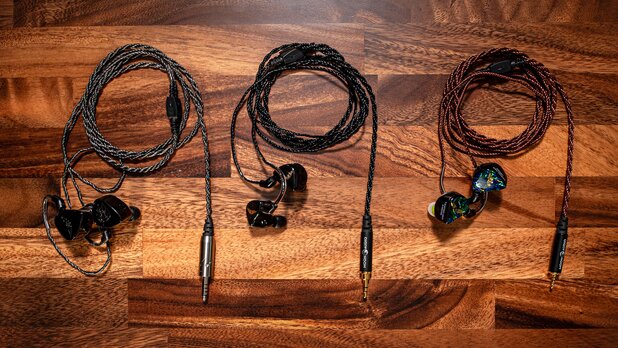
Dragon Cables for Empire Ears IEMs
Choose from our Silver Dragon, Bronze Dragon, and Black Dragon IEM Cables and find the perfect IEM cable for your Empire Ears IEMs
Unboxing Videos
Empire Ears Triton IEMs Launch Edition Unboxing
Empire Ears RAVEN Flagship IEMs Unboxing
Astell&Kern + Empire Ears NOVUS IEMs: Unboxing, Comparison & Review
Empire Ears HERO Unboxing
Empire Ears Legend EVO Dual Conduction In-Ear Monitors Unboxing
Empire Ears ODIN IEMs Unboxing
Reviews & Comparisons
Empire Ears RAVEN IEMs Review: Big, Bountiful Sound
Empire Ears ODIN IEM Review
Empire Ears Legend X IEMs Review
Empire Ears ESR MKII In-Ear Monitors Review
Empire Ears Odyssey IEMs Review & Comparison
Empire Ears Legend X vs. Legend EVO IEMs Comparison & Review
Empire Ears Bravado MKII Universal IEMs Review
Empire Ears Legend EVO IEMs Review
Empire Ears Valkyrie MKII IEMs Review
Verdict
Since first stepping onto the scene in 2015, Empire Ears has established itself as a premier manufacturer of high-quality in-ear monitors, catering to a wide range of audiophiles, musicians, and audio professionals. From the flagship ODIN to the linear, reference-level ESR MKII, Empire Ears has an IEM that's bound to fit your listening style. Those interested in a custom in-ear monitor should reach out to us directly and we can guide you through the entire custom buying process. And don't forget to elevate that listening experience even more with our Dragon Audio Cables. Add clarity and detail to the bass-heavy RAVEN IEMs with the Silver Dragon IEM Cable, or enhance the bottom-end of the Bravado MKII with a Black Dragon IEM Cable–the choice is yours.
Empire Ears' commitment to innovation, evident in their proprietary technologies like synX and EIVEC, continues to push the boundaries of what's possible in personal audio. Whether you're a casual music listener or a demanding audio professional, Empire Ears' diverse range of IEMs provides options that promise to elevate your listening experience to new heights. Discover Empire Ears IEMs and fall in love with your favorite songs all over again.
Related Videos
Custom Dragon IEM Cables: Everything You Need to Know
Headphone Happy Hour, Ep. 5: Empire Ears ODIN IEMs 7 Angry Orchard Peach Cider
Best IEMs for Portable Gaming 2023




